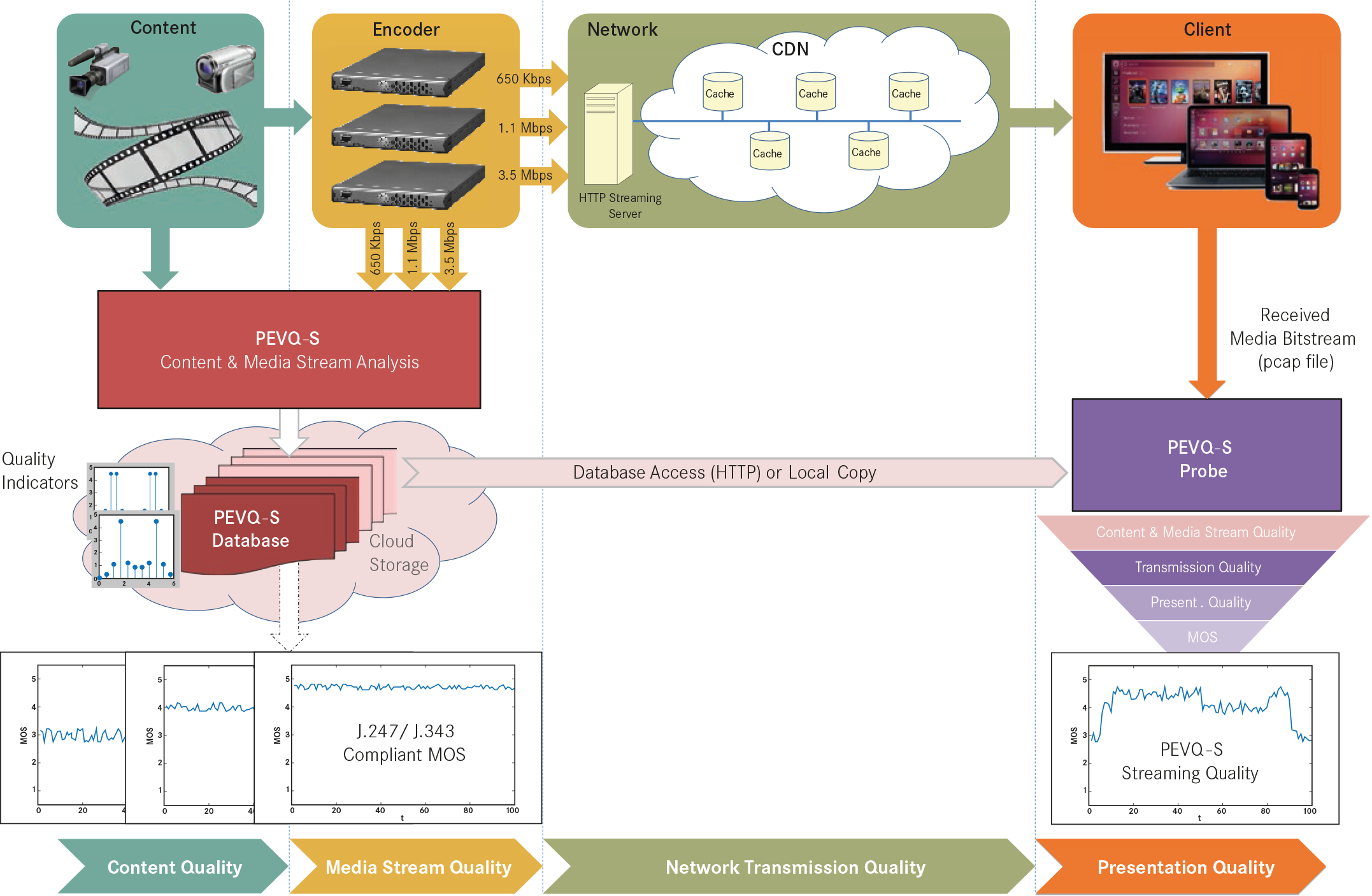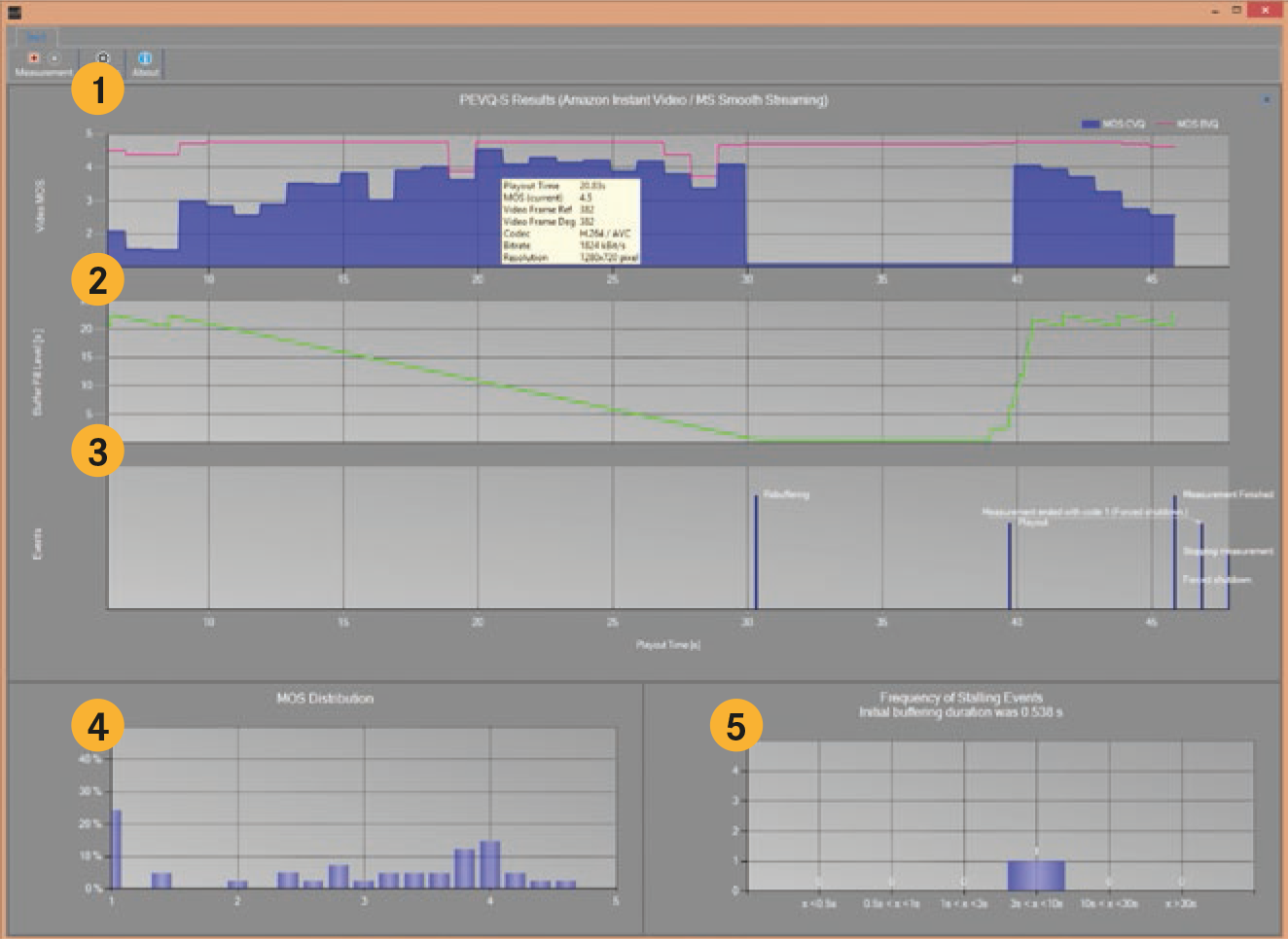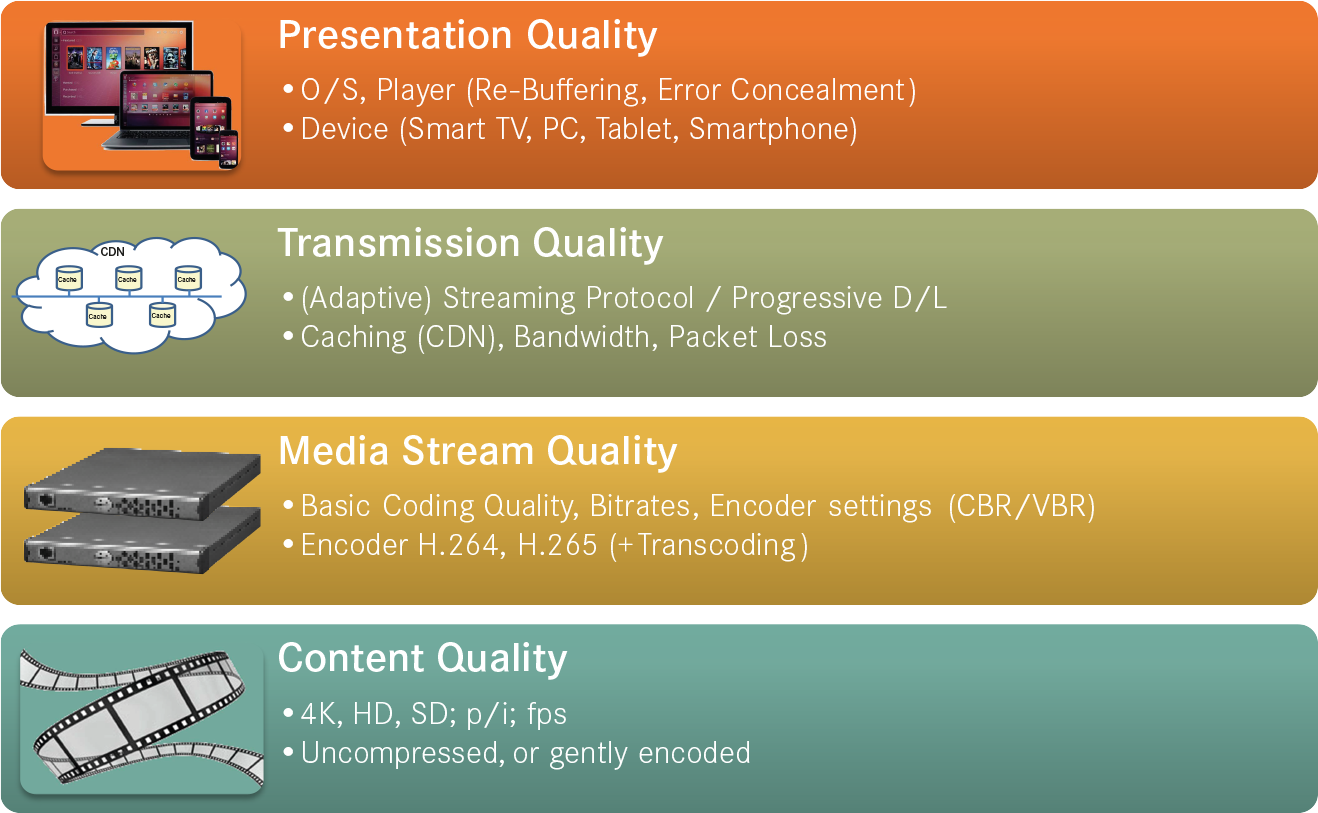PEVQ-S
PEVQ-S - the New Measurement Standard for Video Streaming Quality
PEVQ-S embodies OPTICOM’s advanced architecture for Quality-of-Experience evaluation, benchmarking and optimization of adaptive video streaming services in fixed and mobile networks. Based on its novel hybrid architecture, PEVQ-S combines the high accuracy of PEVQ, the proven industry standard for full-reference perceptual picture quality analysis, with the benefits of a light-weight test probe that can easily be embedded on the client side, even on a Smartphone.
HIGHLIGHTS AND FEATURES
- Hybrid PEVQ MOS:
Perceptual Evaluation of Video Quality, combining true pixel-based picture quality evaluation with bit-stream analysis for fast and accurate subjective MOS prediction. - Optimization Gain Analysis:
The novel hybrid concept allows for true device performance measurement of the Currently Viewed Quality (CVQ), while at the same time analyzing the Best Video Quality (BVQ) available from the server, given optimum encoding and network characteristics. - Benchmarked Accuracy:
PEVQ-S scored top in the latest VQEG benchmark 2014 and is claimed to be the best-in-class hybrid perceptual/bitstream model for objective HD video quality measurement. - Standardized Performance:
PEVQ-S embeds OPTICOM’s advanced PEVQ algorithm, the only commercially available video quality metric that has continuously been benchmarked over the years by several VQEG tests and standardized under ITU-T Recommendations J.247 and J.343 (2014). - Comprehensive E2E Quality:
Contrary to often applied bit stream analysis, PEVQ-S is the only FR perceptual video quality measure to truly score encoder and media stream picture quality with respect to the studio master, and thus able to score and benchmark competitive VoD streaming services.
- Real-time Analysis:
The fully performance-optimized hybrid architecture allows for FR precision of Content & Media Stream Quality Analysis (one-time calculation at the server side) to be combined with lightweight on-line Transmission and Presentation Quality Analysis at the Client Probe – thus allowing for embedded real-time MOS scoring. - Time Scalability:
PEVQ-S is the first perceptual video quality measurement to offer full time-scalability from 2 second chunk (segment) length up to program length of several minutes, even hours. Suitable for benchmarking QoE in a long-term viewer context, not just short clips. - Resolution Scalability:
PEVQ-S supports full scalability from high to low video bitrates and screen sizes (from HD over SD to multimedia screen sizes VGA, QCIF, and CIF). Suitable for analyzing multi-screen programming and multi-network access. - MOS Backward Compatibility:
While PEVQ-S has been extended for longer measurement durations, full J.247 backward compatibility is maintained to calculate P.910 compliant MOS scores for standardized 10 second sequences.
4-layered Quality Architecture
The perceived Quality-of-Experience for Video-on-Demand streaming services depends on many factors, while of course the most prominent artifacts result from the IP transmission network. The software player of the client device dynamically negotiates the bit rate for each chunk with the server, depending on the network congestion and its buffer running empty.
Stalling events will result when the network cannot handle the timely arrival of sequential packets. While, of course, less complex bit stream monitoring techniques might detect frame freezes, too, PEVQ-S evaluates all four quality layers and calculates a MOS score that truly takes the encoding/transcoding quality into account, and interprets all measured values in the relevant context of a particular multi-screen viewing device.
System Overview

Example OTT Network and PEVQ-S Building Blocks: PEVQ-S is split into a hybrid architecture, consisting of two major blocks: the Content & Media Stream Analysis (left, applied at the server side), and the Client Probe (right) analyzing the Transmission and Presentation Quality and processing the final MOS score.
PEVQ-S Example Measurement
The screenshot depicts an adaptive streaming behavior under a congested network condition, with the playback buffer running empty, leading to a stalling event at 30-40s. In this example, video MOS scores are updated every second. The best video quality available from the server is never achieved.

1 The comprehensive PEVQ-S video quality analysis measures both, the Current Video Quality MOS (blue) and the Best available Video Quality MOS (purple) over time. The BVQ MOS is derived from analyzing the picture quality of the media stream with the highest bitrate representation available on the streaming server, regardless if it can be transmitted by the network. As visible from the purple curve, even the “best available quality” not always matches an ‘ideal’ constant MOS of 5.0, but depends on the complexity of the video content and resulting encoding/transcoding artefacts. The headroom left to the blue curve of the CVQ MOS indicates the actual limitation in quality
due to lower connectivity and adaptive bit rate switching and characterizes the transmission quality of the network.
2 The green curve shows the monitored playback buffer. It will rise while the buffer is filled with arriving chunks, and will drop during stalling events, while the buffer is playing out data without refill.
3 The event display indicates every time the buffer is refilled by new chunks arriving. Combined with the buffer fill level display and the video MOS scoring, a comprehensive analysis of the player behavior can be achieved.
4 At the left bottom of the screen, the overall video QoE is shown in a MOS histogram, representing the distribution of different quality levels from 1 (’poor’, left) to 5 (‘excellent’, right).
5 At the right bottom of the screen, the stalling behavior is summarized in a histogram.
Solution Benefits
Understand the Video Quality delivered to your subscriber:
For a sustainable adoption of IP-based OTT video services subscriber Quality-of-Experience is king. To be competitive, QoE needs to meet or exceed established satellite and cable-TV standards. Key benefits of deploying PEVQ-S include:
- Truly measure and competitively benchmark picture quality in a long-term context as perceived by subscribers
- Standards based video quality measurement, fully backward compatible with ITU-T J.247 and P.910 subjective tests
- Optimize OTT service offerings, CDN deployments and caching strategies
- Benchmark and optimize video streaming characteristics of mobile networks
- Differentiate your OTT service offering from the competition and incumbent TV, Mobile-TV and IPTV services
- Monetize VoD services, increase customer satisfaction, reduce churn
- Lower support and servicing costs by App-based testing solutions
Example Applications
- Evaluation and performance measurement of streaming video services
- Optimization of encoding bitrates, network bandwidth, CDN and caching strategies
- Benchmarking of competitive VoD streaming services
- Performance testing and comparison of multi-screen devices (Smart-TVs, Connected-TVs, PCs, Laptops, Tablets, Smartphones)
- Drive and Walk Testing of 3G, 4G/LTE Mobile Networks
- Embedded Video QoE App for Smartphones and Tablets
- Picture Quality Analyzers and standard T&M equipment
More Information / Download
Download PEVQ-S Data Sheet PDF [1.76 MB]
Ordering Information
Please contact your OPTICOM sales representative to discuss your use case and to understand how PEVQ-S may be customized for your specific network and streaming protocol requirements and work flow needs. OEM license models available for system integrators and T&M manufacturers.
For more information, please visit www.pevq.org


















